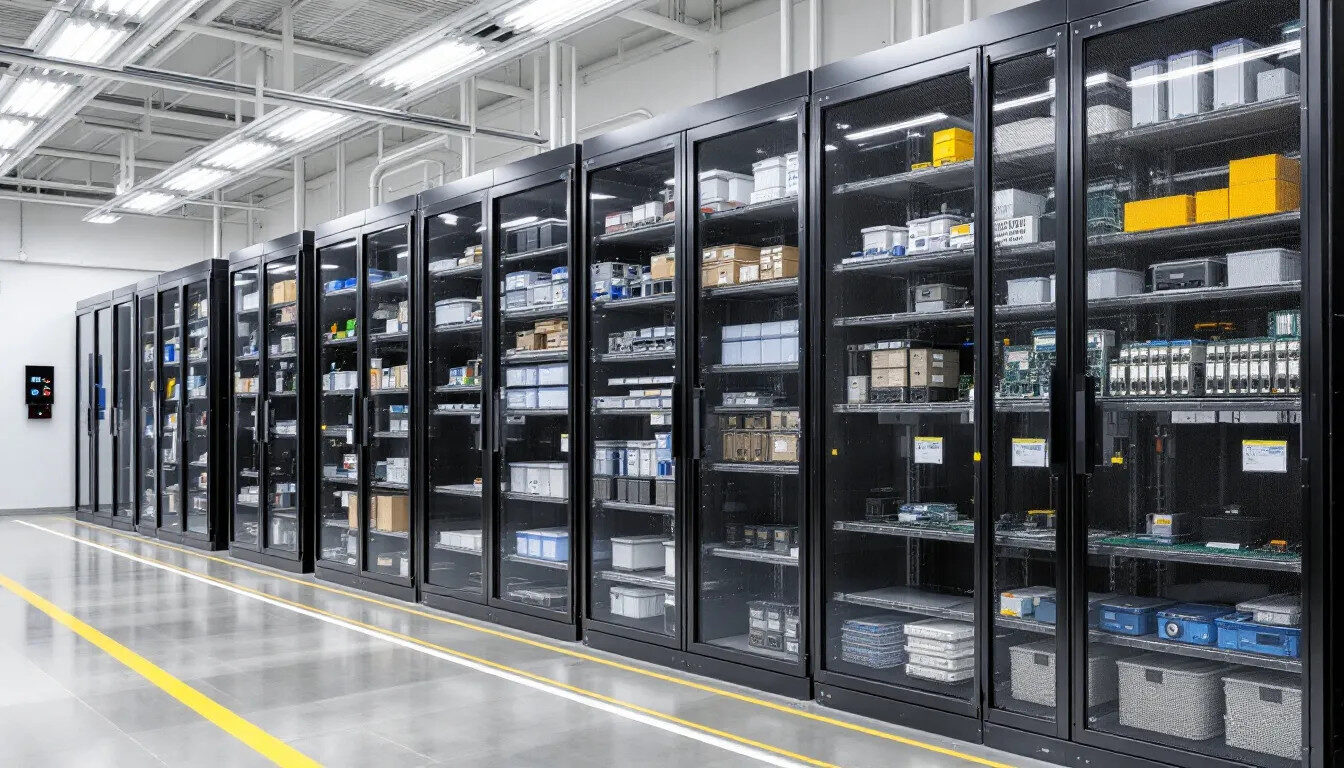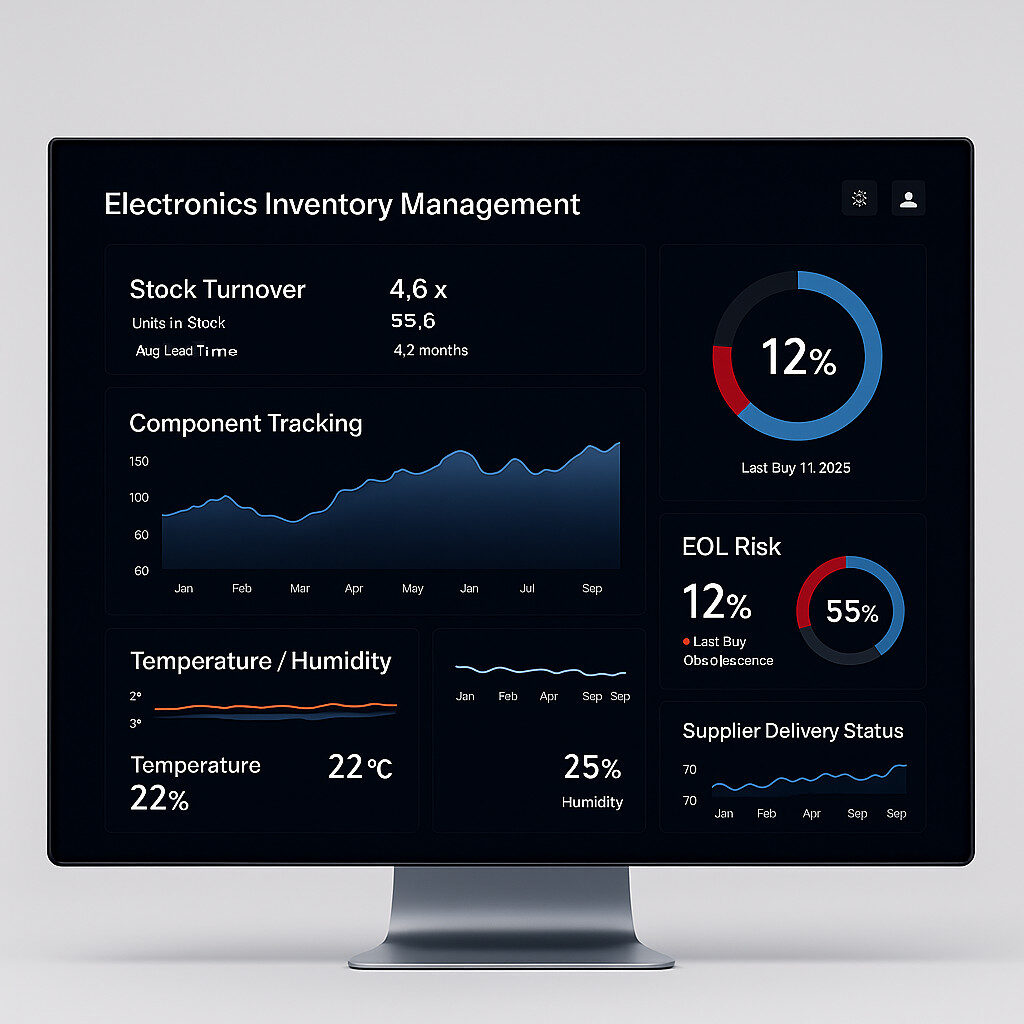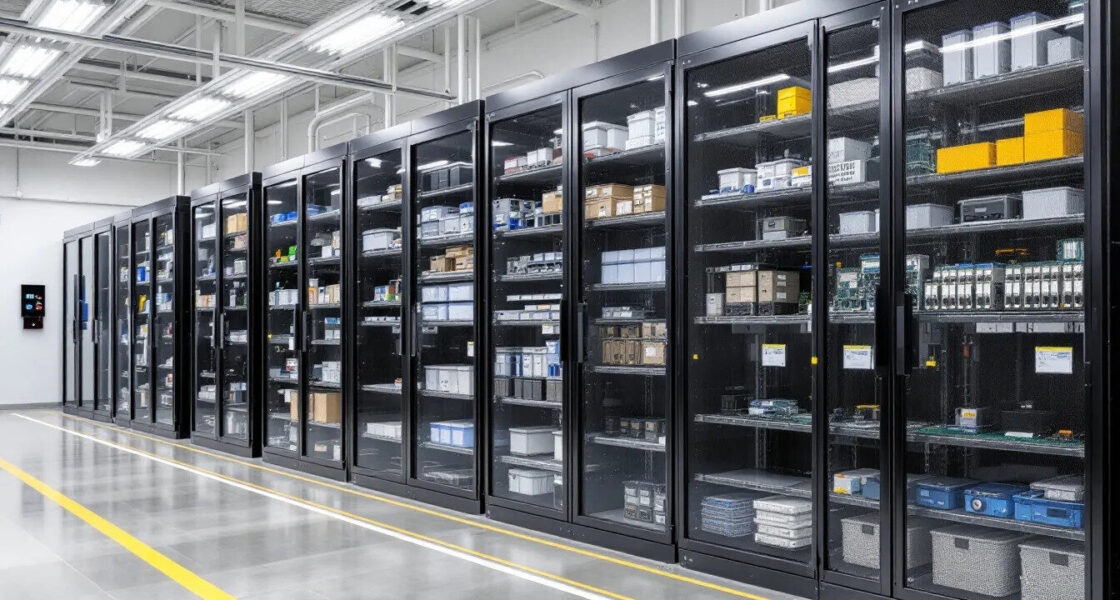Key Takeaways
- Electronics inventory management requires specialized approaches due to rapid obsolescence, ESD sensitivity, and short product lifecycles that can impact 20–30% of working capital.
- Excess inventory in electronics drains resources through storage costs and tied-up capital, but can be monetized via global resale networks that often recover 40–70% of the original investment.
- Effective strategies combine real-time tracking, predictive analytics, and climate-controlled storage to maintain component quality and prevent costly obsolescence.
- Modern solutions such as RFID, IoT sensors, and AI-powered systems help optimize purchasing decisions and reduce the risk of unexpected end-of-life (EOL) events.
- Strategic cost management through proper storage, supplier partnerships, and lifecycle tracking can reduce total inventory costs by 15–25% while improving fill rates.
The electronics industry faces unique inventory challenges that can make or break profitability. With components becoming obsolete within 12–18 months and working capital requirements often representing 20–30% of total inventory value, effective inventory management has become a critical competitive advantage.
Unlike general inventory, electronics require specialized handling, climate-controlled environments, and sophisticated tracking to maintain component integrity. The rapid pace of technological change means excess inventory can quickly shift from assets to liabilities.
This guide covers proven strategies to optimize electronic component inventory — from preventing obsolescence to recovering value from surplus stock — and how leading manufacturers and distributors leverage technology, storage optimization, and strategic partnerships to maximize efficiency while minimizing costs.
What Is Electronics Inventory Management?
Electronics inventory management comprises specialized processes and systems to track, store, and optimize electronic components, finished devices, and related materials across the supply chain.
It goes beyond standard control by encompassing electrostatic discharge (ESD) protection, environmental monitoring, and lifecycle tracking. Many components are sensitive to temperature, humidity, and handling, and some have limited shelf lives or rapid obsolescence cycles that can render them unusable within months.
Key differences from general inventory management include:
- ESD-safe handling procedures
- Climate-controlled storage environments
- Detailed lifecycle and supplier end-of-life tracking
Effective management ensures supply continuity, maintains product reliability, and protects profitability — not just stock accuracy.

Unique Challenges in Electronics Inventory Management
Managing electronics inventory involves variables traditional systems struggle to address:
Rapid Technology Obsolescence
Components often become outdated within 12–18 months, requiring a balance between availability and over-accumulation.
Electrostatic Discharge (ESD) Sensitivity
Minimal static can damage components, necessitating specialized workspaces, grounding systems, and regular staff training.
Strict Environmental Controls
Most components need stable conditions — typically 20–25 °C and 45–75 % RH — to avoid corrosion or drift.
Limited Shelf Life
Batteries and electrolytic capacitors may last ~2 years, requiring strict rotation and usage policies.
Global Supply Chain Complexity
Sourcing across continents increases variability in lead times and quality, demanding synchronized planning and forecasting.
Managing Excess Electronic Inventory
Once the fundamentals are in place, the next major challenge is managing what happens when inventory exceeds demand.
Excess stock can quickly erode profitability and warehouse efficiency if not handled strategically.
Excess inventory often results from demand fluctuations, design changes, order cancellations, or over-forecasting. In electronics, short lifecycles mean excess stock can lose value fast.
Beyond finance, improper disposal contributes to e-waste — so responsible resale, repurposing, or recycling not only recovers value but also supports sustainability goals.
Common causes:
- Demand volatility and supply-chain disruptions
- Over-forecasting or panic-buying during shortages
- Product redesigns and discontinuations
Options for Managing Surplus Stock
1. Selling Excess Components
Selling is most effective when parts still have active lifecycles and market demand.
- Components with ≥ 12 months before EOL retain higher resale value.
- Broad-use parts sell more easily than niche ones.
- Trusted global buyer networks can often recover 40–70 % of the purchase price within 30–60 days.
Assess before selling:
- Market demand trends
- Remaining shelf life
- Storage and handling costs
- Strategic future use potential
2. Repurposing Inventory Internally
Internal repurposing is often the most cost-effective path. Unused components from one project may fit another.
- Cross-project utilization reduces new purchases.
- Engineering collaboration ensures compatibility in updated designs.
- Internal marketplaces enable visibility and transfers between teams or sites.
Maintain detailed databases of excess stock (specs, condition) to surface reuse opportunities early in design cycles.
3. Storing Components Long-Term
Long-term storage makes sense for parts tied to multi-year service contracts or products requiring extended support (e.g., aerospace, medical, industrial).
Consider storage when:
- Demand is confirmed by contracts or forecasts.
- Components have stable, long shelf lives.
- Storage costs are lower than likely future procurement costs.
Long-term storage requires climate control, ESD protection, documented inspections, and periodic rotation to maintain usability.

Technology Solutions for Electronics Inventory Management
Modern technology enables real-time visibility and control:
- RFID & Barcodes: Component-level traceability; fewer manual errors.
- Predictive Analytics: Forecast demand and identify obsolescence risks from market and supplier data.
- ERP Integration: Synchronize procurement, production, engineering, and finance for unified decisions.
- IoT Sensors: Monitor temperature and humidity continuously; trigger alerts and automatic adjustments.
- AI-Powered Tools: Anticipate supplier discontinuations and EOL patterns early.
Storage Requirements for Electronic Components
Proper storage safeguards quality and longevity.
Key requirements:
- Temperature & Humidity Control: 20–25 °C, 45–75 % RH
- ESD-Safe Environments: Grounding, ionization, ESD-safe materials and containers
- Moisture-Sensitive Devices (MSD): Dry cabinets, sealed packaging, indicator cards, and bake-out protocols
- FIFO Systems: Use older stock first to minimize aging
- Security Measures: Access control, surveillance, item-level tracking, and audit trails
Best Practices for Electronics Inventory Optimization
- ABC Analysis: Prioritize high-value/critical parts.
- Reorder Points: Base on demand variability, lead-time reliability, and service-level targets.
- Cycle Counts & Annual Audits: Monthly for high-value, quarterly for standard items; annual physical verification.
- Supplier Partnerships / VMI: Reduce carrying costs and improve availability for standard components.
- Cross-Training: ESD handling, MSD rules, counterfeit recognition.
- Documentation & Traceability: Provenance, storage conditions, handling history for quality and compliance.
Cost Management Strategies
- Total Cost of Ownership (TCO): Include storage, handling, obsolescence, insurance, and capital costs.
- Volume Purchasing: Negotiate tiers without triggering overstock; watch minimums.
- Consignment Inventory: Ownership stays with suppliers until consumption.
- Just-in-Time (JIT): Align deliveries with production schedules (requires high supplier reliability).
- Price Monitoring & Timing: Buy in favorable windows; avoid peak pricing.
- Shipping Optimization: Consolidation, carrier negotiations, and protective packaging for ESD safety.
- Working Capital Optimization: Balance service levels with cash flow.
- Monetize Surplus: Partner with reputable brokers/remarketers for responsible value recovery.
Ultimately, efficient cost management transforms inventory from a passive expense into an active driver of resilience and competitiveness.

Finally, build sustainable practices: recycle EOL components, work with suppliers who support sustainability goals, and favor eco-friendly packaging where feasible.
Frequently Asked Questions
How often should electronics inventory be audited?
Count high-value components monthly; audit standard items quarterly. Conduct an annual full physical verification. RFID can enable more frequent automated checks with minimal labor.
What is the typical shelf life of electronic components?
It depends on type and storage: electrolytic capacitors ~2–5 years; integrated circuits up to 10+ years (properly stored); MSDs have 24–168 hours floor life after opening; batteries generally have the shortest life and require careful rotation.
How can I prevent component obsolescence in my inventory?
Use lifecycle tracking, monitor supplier EOL notices, and apply predictive analytics. Maintain strong supplier relationships for early warnings and review slow-moving stock regularly.
What are the key metrics for measuring inventory performance?
- Inventory turnover: ~4–6× annually (typical)
- Obsolescence rate: < 2 % of total inventory value
- Fill rate: > 95 % for production-critical components
- Carrying cost: ~20–30 % of inventory value per year
How do I choose between selling excess inventory or storing it?
Sell if a part is nearing EOL, demand is declining, or annual storage costs exceed ~25 % of value. Store only with confirmed future demand and sufficient remaining lifecycle to justify costs — and consider the opportunity cost of tied-up capital.




